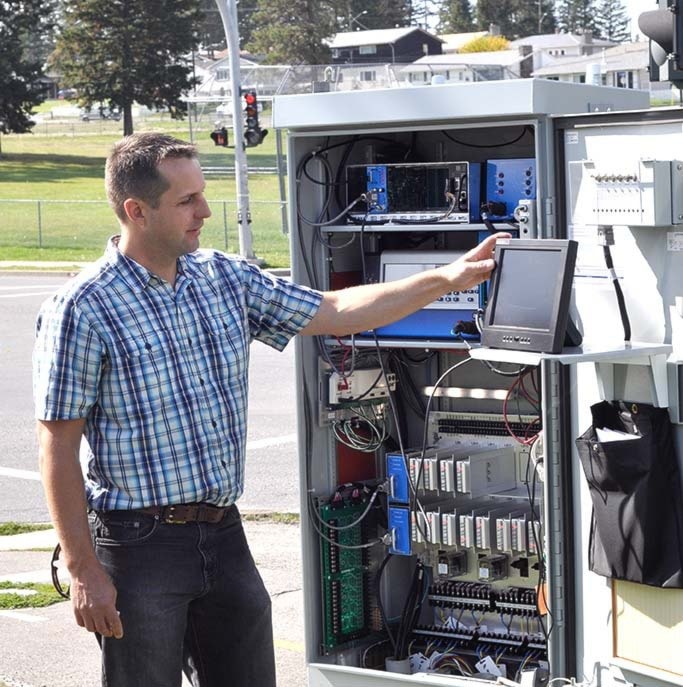A new traffic lights system controlled by computers and cameras has been installed and is running for the first time in Cranbrook.
The intersection of Victoria Avenue and 2nd Street South is now fully equipped with the new system that seems to be moving traffic along at a steady pace. The city provided a tour to local media on Tuesday afternoon, and traffic seemed to flow effortlessly through the intersection in all directions.
The intersection uses a complex computer system that automatically sees vehicles as they pull up to the intersection. A screen within the nearby electrical box shows a live feed of the intersection. Over each lane there is a grey box superimposed and as a car or truck or even motorcycle enters the lane area green arrows appear over the box, signalling the system to change the lights.
It’s all quite a detour from the old system of large sensor rings that are imbedded in the asphalt in the lanes.
Tony Hetu, City Electrician and Trades Manager, said the upgrade was one that was greatly needed as the infrastructure was first installed in the ‘90s. The life cycle of the equipment is usually 15-20 years, so the upgrade is well overdue.
“For the old system, all the sensors are in the road, so what would happen in the winter with all the moisture, they were starting to fail,” Hetu said. “They are about the same age as our intersections. So we were looking at an upgrade. The cameras were basically the same cost as replacing the old system. I think it’s far superior.”
Hetu said the cost all-in for the new system was about $25,000. He noted that the cost for a contractor to put in a single sensor ring can be $4,000 and that particular intersection has nine of them, one for each lane.
Hetu said the main reason they went with that intersection as the first one was its proximity to the fire hall. The lights also have a system that can be controlled from the fire hall, as well as a GPS beacon on the firetruck, that allows the firetruck to have right of way through the intersection and stop other traffic.
It is also one of the busiest in town. He noted that all of the highway corridor traffic lights are under the jurisdiction Ministry of Transportation and Infrastructure. Minus those intersections, there are nine total in the city, and seven of those are still on the old weight sensor system.
Hetu said the cameras actually require less technological devices than the old sensors.
“The old sensors we would have route detectors for every single lane,” he said.
There are also safeties that puts the whole system into four way flashing if there is a failure.
Hetu said with the system it’s not possible to have green lights simultaneously in different directions, even in the event of a failure.
The city will began work on the Victoria and 2nd Street North to switch on the new system. The cameras are already installed above the traffic lights.
A wireless ethernet connection allows the Trades department at the city to see any issues with the lights, as well as compile stats about traffic counts and usage.
